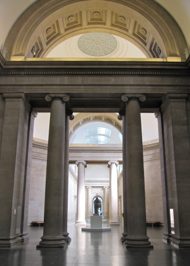Tate Britain
the embankment
LONDON, england,great britain, united kingdom
europe
May 28, 2011


Tate Britain
the embankment
LONDON, england,great britain, united kingdom
europe
May 28, 2011


Tate Britain, the venerable gallery of British art that stands on the Embankment overlooking the Thames, was built between 1889 and 1897 on the site of the former Millbank prison, opened in 1821 and closed in 1897. This complex building has grown over time during the past 110 years, with additions and alterations accommodating the changing needs of the collection. The original building, built to house Henry Tate’s donated collection, contained seven rooms on the main level, with an upper level and watercolor gallery designed by the architect, Sidney Smith. The building has been undergoing a major transformation since 2010. Major upgrades to the galleries is being undertaken to provide more space for a wider range of art and media. Learning studios and public spaces will be added by opening up the domed atrium at the heart of the gallery. Budgeted at £45 million, the new renovations are slated to be complete by 2013. Visiting Tate Britain is a pilgrimage coupled with a visit to the Tate Modern. Henry and I approached Tate Britain by taking the water taxi upstream from the former power-station-turned-contemporary-museum to see the collection of the older, Tate Britain. Our goal was to re-visit the paintings bequeathed by JMW Turner. Upon entry into the museum, however, we were also able to see a sculpture exhibition of British sculpture ,and some of the 20th century works of art by Lucien Freud, Francis Bacon, and many other artists we truly admire. Despite the museum’s renovations to accommodate various contemporary art mediums, the museum was open and available with the consistent high quality of professionalism we expect to see in this respected museum.
PHOTOS: Top Three: 1. The elegant central galleries on the ground floor of Tate Britain. 2. The façade of Tate Britain, a Neo-Classic building designed by Sidney Smith, opened in 1897. 3. The domed atrium in the heart of the gallery, with plans to renovate this space by 2013. Middle Three: 1. Carl Miles (1875-1955) The Sun Singer (Torso) 1922. 2. Lucien Freud (b. 1922) Girl with a Kitten, 1947. 3. Henry Moore (1898-1986) Woman 1957-58, Bronze. Bottom Two: 1. Francis Bacon (1909-1992) Three Studies for Figures at the Base of a Crucifixion, c. 1944. Oil on board. 2. Kenneth Armitage (1916-2002) People in the Wind, 1950. Bronze.

British Art







